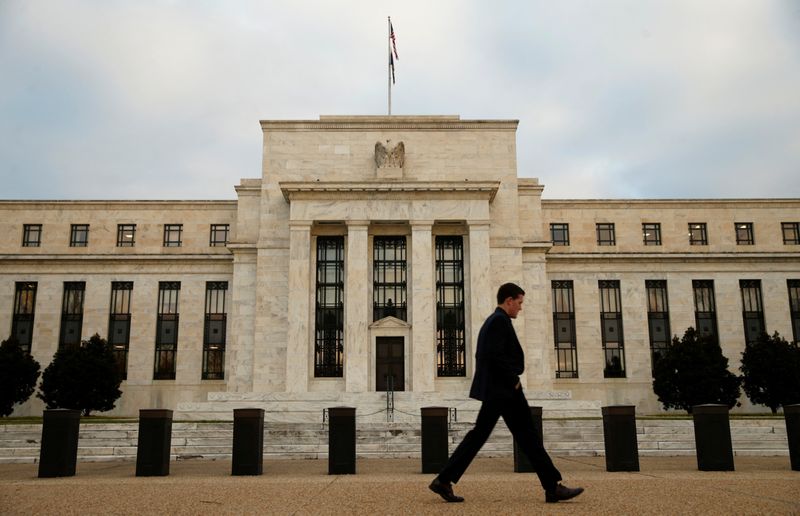By Pete Schroeder
WASHINGTON (Reuters) -The U.S. Federal Reserve is due to release the results of its annual bank health checks on Wednesday at 4:30 p.m. ET (2030 GMT). Under the "stress test" exercise, the Fed tests big banks' balance sheets against a hypothetical severe economic downturn, the elements of which change annually.
The results dictate how much capital those banks need to be healthy and how much they can return to shareholders via share buybacks and dividends. Big U.S. lenders are expected to show they have ample capital to weather any fresh turmoil in the banking sector.
WHY DOES THE FED 'STRESS TEST' BANKS?
The Fed established the tests following the 2007-2009 financial crisis as a tool to ensure banks could withstand a similar shock in future. The tests formally began in 2011, and large lenders initially struggled to earn passing grades.
Citigroup , Bank of America, JPMorgan Chase & Co and Goldman Sachs Group (NYSE:GS), for example, had to adjust their capital plans to address the Fed's concerns. Deutsche Bank (ETR:DBKGn)'s U.S. subsidiary failed in 2015, 2016 and 2018.
However, years of practice have made banks more adept at the tests and the Fed also has made the tests more transparent. It ended much of the drama of the tests by scrapping the "pass-fail" model and introducing a more nuanced, bank-specific capital regime.
SO HOW ARE BANKS ASSESSED NOW?
The test assesses whether banks would stay above the required 4.5% minimum capital ratio during the hypothetical downturn. Banks that perform strongly typically stay well above that. The nation's largest global banks also must hold an additional "G-SIB surcharge" of at least 1%.
How well a bank performs on the test also dictates the size of its "stress capital buffer," an additional layer of capital introduced in 2020 which sits on top of the 4.5% minimum.
That extra cushion is determined by each bank's hypothetical losses. The larger the losses, the larger the buffer.
THE ROLL OUT
The Fed will release the results after markets close. It typically publishes aggregate industry losses, and individual bank losses including details on how specific portfolios - like credit cards or mortgages - fared.
The Fed does not allow banks to announce their plans for dividends and buybacks until typically a few days after the results. It announces the size of each bank's stress capital buffer in the subsequent months.
The country's largest lenders, particularly JPMorgan Citigroup, Wells Fargo & Co, Bank of America, Goldman Sachs, and Morgan Stanley (NYSE:MS) are closely watched by the markets.
A TOUGHER TEST?
The Fed changes the scenarios each year. They take months to devise and test a snapshot of banks' balance sheets at the end of the previous year. That means they risk becoming outdated.
In 2020, for example, the real economic crash caused by the COVID-19 pandemic was by many measures more severe than the Fed's scenario that year.
The 2023 tests were devised before this year's banking crisis in which Silicon Valley Bank and two other lenders failed. They found themselves on the wrong end of Fed interest rate hikes, suffering large unrealized losses on their U.S. Treasury bond holdings which spooked uninsured depositors.
The Fed has come under criticism for not having tested bank balance sheets against a rising interest rate environment, instead assuming rates would fall amid a severe recession.
Still, the 2023 test is expected to be more difficult than in previous years because the actual economic baseline is healthier. That means spikes in unemployment and drops in the size of the economy under the test are felt more acutely.
For example, the 2022 stress test envisioned a 5.8 percentage point jump in unemployment under a "severely adverse" scenario. In 2023, that increase is 6.5 percentage points, thanks to rising employment over the past year.
As a result, analysts expect banks will be told to set aside slightly more capital than in 2022 to account for expected growth in modeled losses.
STRESSES IN COMMERCIAL REAL ESTATE, CORPORATE DEBT
The exam also envisages a 40% slump in the prices of commercial real estate, an area of greater concern this year as lingering pandemic-era office vacancies stress borrowers.
In addition, banks with large trading operations will be tested against a "global market shock," and some will also be tested against the failure of their largest counterparty.
For the first time, the Fed will also conduct an extra "exploratory market shock" against the eight largest and most complex firms, which will be another severe downturn but with slightly different characteristics.
This extra test will not count towards banks' capital requirements but will allow the Fed to explore applying multiple adverse scenarios in future. Fed Vice Chair for Supervision Michael Barr has said multiple scenarios could make the tests better at detecting banks' weaknesses.
WHICH FIRMS ARE TESTED?
In 2023, 23 banks will be tested. That's down from 34 banks in 2022, as the Fed decided in 2019 to allow banks with between $100 billion and $250 billion in assets to be tested every other year.
Here are the banks being tested this year:
Bank of America Corporation (NYSE:BAC)
The Bank of New York Mellon (NYSE:BK) Corporation
Barclays (LON:BARC) US LLC
BMO Financial Corp.
Capital One Financial Corporation (NYSE:COF)
The Charles Schwab Corporation (NYSE:SCHW)
Citigroup Inc (NYSE:C).
Citizens Financial (NYSE:CFG) Group, Inc.
Credit Suisse Holdings (USA), Inc.
DB USA Corporation
The Goldman Sachs Group, Inc.
JPMorgan Chase & Co. (NYSE:JPM)
M&T Bank Corporation (NYSE:MTB)
Morgan Stanley
Northern Trust Corporation (NASDAQ:NTRS)
The PNC Financial Services Group (NYSE:PNC), Inc.
RBC US Group Holdings LLC 2
State Street Corporation (NYSE:STT)
TD Group US Holdings LLC
Truist Financial (NYSE:TFC) Corporation
UBS Americas Holding LLC

U.S. Bancorp
Wells Fargo & Company (NYSE:WFC)